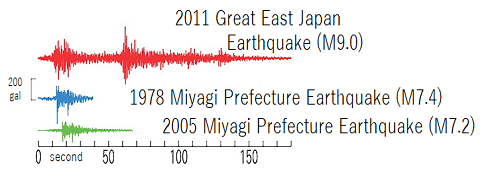What we learn from the Great East Japan Earthquake
A major feature of the Great East Japan Earthquake was that…
・Largest M9.0 earthquake in Japan's history
・The duration of the shaking was an unexpected 3 minutes
・Huge tsunami over 40 meters high
there is.
A huge earthquake of M9.0
The Great East Japan Earthquake caused violent shaking mainly on the Pacific coast, with a seismic intensity of 7 in Miyagi Prefecture. A seismic intensity of 6+ was observed in Fukushima, Ibaraki, and Tochigi prefectures.
At this time, long-period vibrations were observed in Tokyo that caused large buildings such as skyscrapers to shake slowly and violently.
The Great East Japan Earthquake shook all of Japan and became the fourth largest earthquake in the world since 1900.
The duration of the shaking was an unexpected 3 minutes
©Source: Adapted from Masato Minamiei, Tohoku University  |
Comparing the earthquakes that have occurred in Miyagi Prefecture in the past with the Great East Japan Earthquake, the mega-earthquake was 4.5 times longer than the tremor duration of the 1978 Miyagi Prefecture-Oki Earthquake (M7.4), and 3 times longer than the 2005 Miyagi Prefecture-Oki Earthquake (M7.2) It turned out that the duration of the shaking was tripled. |
|---|
Huge tsunami over 40 meters high
The tsunami caused the most damage in the Great East Japan Earthquake. A tsunami swept across the Pacific coast of the Tohoku region.
The highest tsunami height that can be confirmed at the Japan Meteorological Agency tide gauge station
Soma City, Fukushima Prefecture 9.3meters or more
Ishinomaki City, Miyagi Prefecture 8.6meters or more
Miyako City, Iwate Prefecture 8.5meters or more
In some places, the height of the tsunami was so high that it was impossible to observe it at tide stations. The table below shows the tsunami record.
Actual tsunami height
Ofunato City, Iwate Prefecture 40meters
Miyako City, Iwate Prefecture 39.75meters
Soma City, Fukushima Prefecture 21.3meters
Iwaki City, Fukushima Prefecture 15.77meters
As you can see from the table above, the Pacific coast of Tohoku was hit by a huge tsunami exceeding 10 meters in height.
Now that we know how scary earthquakes are, what should we do if an earthquake occurs? Also, what measures should we take before an earthquake occurs?
If there is an earthquake indoors
When an earthquake occurs inside your house
If you are in a housePrioritize your life. First, protect yourself and then prevent secondary damage such as fire.
1. Move under the tableThe most dangerous thing during an earthquake is having something fall from above. Therefore, try to hide under a table where you can protect yourself.
2.Securing an escape exitIf the house is distorted due to an earthquake, the front door may not open. In order to be able to escape after an earthquake, be sure to secure the entrance and exit immediately after opening the door.
3. Putting out the fireWhen an earthquake occurs, it is very important to put out fires. Turn off the fire and turn off the gas valve before escaping.
supplement
During the Great Hanshin Earthquake, there was a case where the damage and fire caused by secondary disasters were worse than the collapse caused by the earthquake.
If there is an earthquake in the elevator
To avoid getting trapped in the elevator, press the button for every floor and get off at the floor where it stops.
*However, when getting off, don't panic and judge the situation on that floor.
If you sense an earthquake and have to make an emergency stop, use the emergency intercom to contact outside parties and follow instructions.
If there is an earthquake outdoors
If there is an earthquake inside the vehicle
When an earthquake occurs, vehicles will come to an emergency stop.
Protect your head by keeping your head low when sitting,
and holding on to handrails or straps when standing to prevent falls.
When you are in a residential or office area
In residential areas, block walls, vending machines, utility poles, etc. may break, and buildings may collapse. Protect your head with a bag, keep your head away from walls and buildings, and wait for the shaking to subside.
Actions to take during evacuation
Secondary disasters such as fires and tsunamis are predicted, so evacuate to a temporary gathering point or a wide-area evacuation site.
Coastal areas and estuary areas are at risk of tsunamis, so evacuate to higher ground.
supplement
In order to evacuate safely and quickly,
it is important to check in advance and conduct evacuation drills.
In either case, be sure to check the evacuation route and evacuation location.
Confirming the safety of neighboring residents and helping each other
Mutual help can be divided into self-help, which is undertaken by one person,mutual assistance, which is undertaken by the community or people close to you, andpublic assistance, which is undertaken by the national and local governments. Wait until you are able to secure yourself before rescuing nearby residents. However, if you find someone who needs rescue, do not try to do it alone; be sure to do it with multiple people.
- Why do earthquakes occur?
- About the Nankai Trough mega-earthquake
- Damage caused by the Nankai Trough
- Earthquake preparation
- emergency preparedness
- What we learn from the Great East Japan Earthquake
- If there is an earthquake indoors
- If there is an earthquake outdoors
- Actions to take during evacuation
- site map
- 日本語
language


